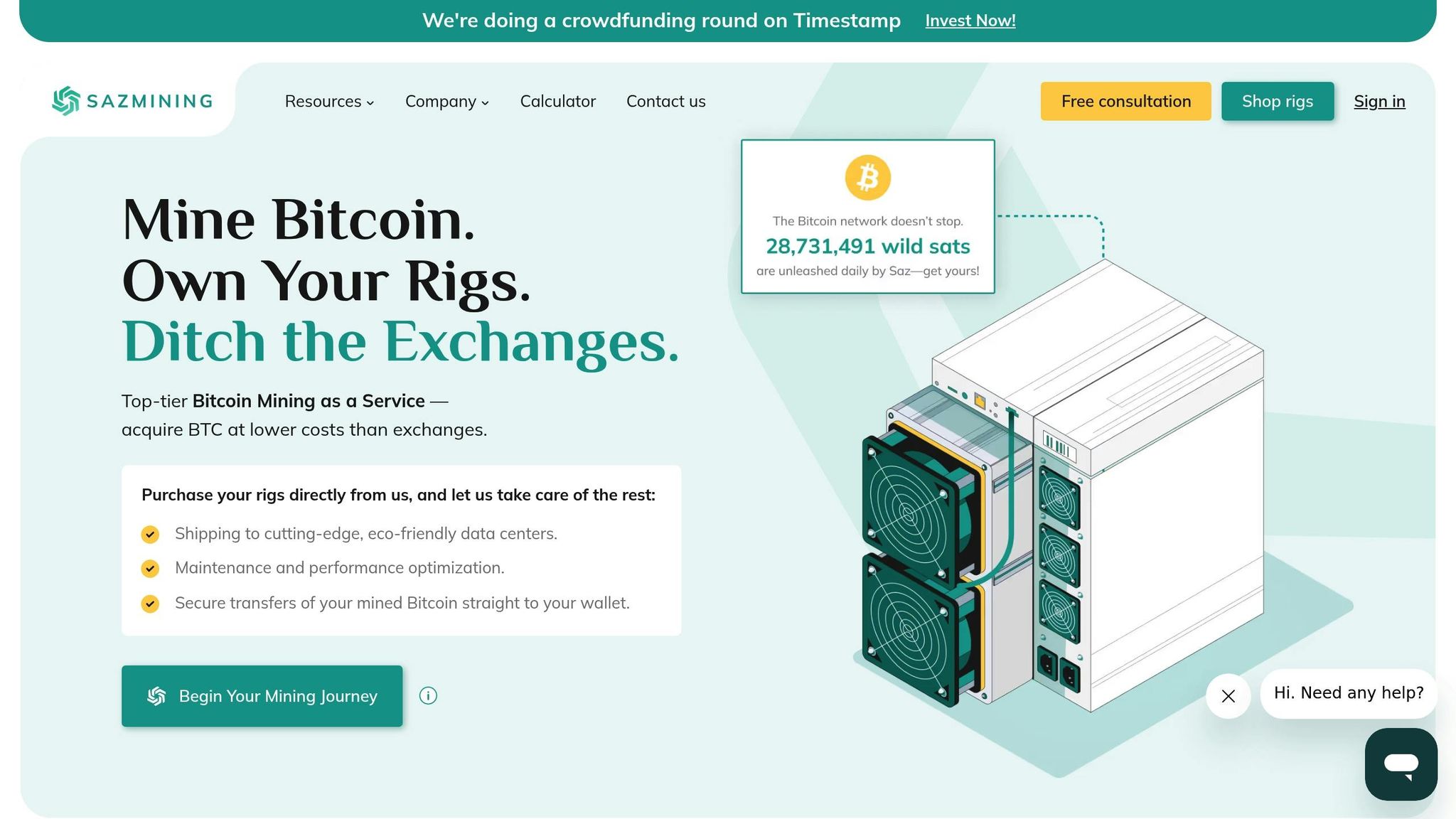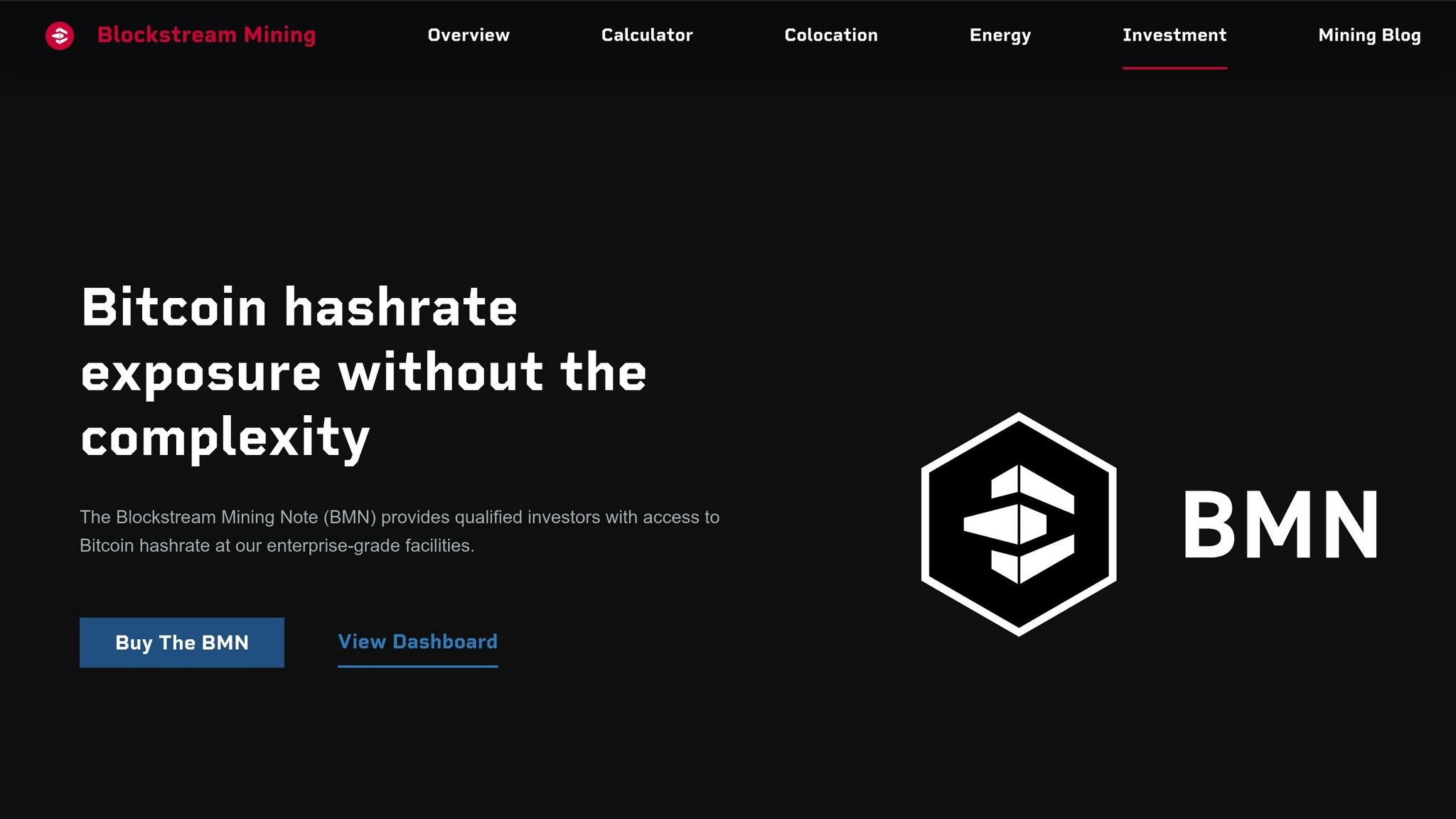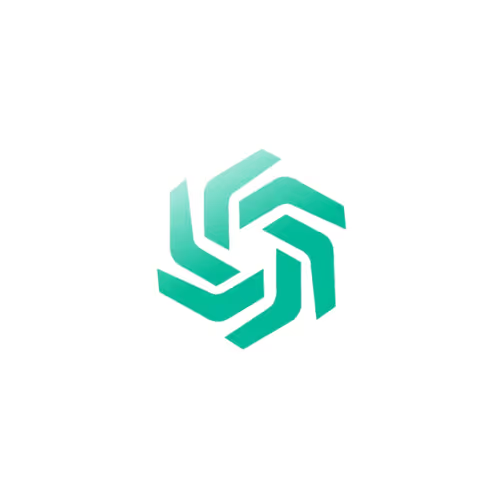Bitcoin mining offers two main investment models: Mining as a Service (MaaS) and securitized hash rate products. Here's the difference:
- Mining as a Service (MaaS): You own mining hardware hosted and managed by professionals. This model gives you direct Bitcoin payouts, full ownership of the equipment, and transparency into costs and performance. U.S. investors can easily access this option, with platforms like Sazmining offering renewable energy-powered data centers.
- Securitized Hash Rate Products: These are tokenized securities tied to mining capacity, like Blockstream Mining Notes (BMN). They provide exposure to mining returns without hardware ownership. However, U.S. investors face restrictions due to regulatory barriers, and there’s less control over energy sourcing and operations.
Key Takeaway: MaaS is ideal for investors seeking direct ownership, transparency, and fewer regulatory hurdles, while securitized products suit those prioritizing liquidity and hands-off investing. For U.S. residents, MaaS is the more accessible and straightforward choice.
Is Crypto Mining Hosting SAFE? Host Vs Miner WAR!
What is Mining as a Service (MaaS)?
Mining as a Service (MaaS) allows investors to participate in Bitcoin mining without dealing with the technical challenges of setting up and managing mining equipment. Essentially, you purchase mining hardware, but instead of handling it yourself, the equipment is hosted in professional data centers designed specifically for mining operations.
These facilities are equipped with industrial-grade power, cooling systems, and 24/7 monitoring. With MaaS, you own the mining hardware and the Bitcoin it generates, while professionals take care of the day-to-day operations.
How MaaS Works
When you invest in MaaS, you purchase and ship mining rigs to professional data centers. These centers handle the installation, maintenance, and optimization of your equipment. The rigs work non-stop, solving complex mathematical puzzles to validate Bitcoin transactions and earn block rewards. Any Bitcoin generated is sent directly to your wallet.
Professional data centers used in MaaS often rely on renewable energy sources, addressing concerns about Bitcoin mining's environmental impact. Many of these centers are strategically located near hydroelectric dams, solar power plants, or wind farms, where clean energy is both plentiful and affordable.
Service providers charge a monthly fee to cover expenses like hosting, electricity, maintenance, and technical support. This fee structure ensures the provider’s success is tied to your mining profitability - they only earn when your hardware is running efficiently.
Sazmining, a key player in the MaaS space, takes this concept further with competitive pricing and strong service guarantees.
Sazmining's MaaS Features

Sazmining stands out in the MaaS market by offering transparency and direct ownership, setting it apart from traditional cloud mining services. The company emphasizes clear pricing and customer control over assets.
When you purchase a mining rig through Sazmining, you pay the same price they pay to manufacturers like Bitmain, with no hidden markups on equipment or electricity costs. This straightforward approach ensures you’re not overpaying for your investment.
Sazmining's data centers in Paraguay run entirely on hydropower, providing access to some of the cheapest and cleanest electricity in the world. This not only reduces operational costs but also increases profitability for investors.
Their offerings include mining rigs like the Bitmain S19 XP Hydro, available in configurations of 246 TH/s and 257 TH/s. These rigs are priced at $3,847 and $3,997, respectively, with monthly fees of $239 and $250. Each purchase is supported by a 90% annual performance guarantee, ensuring reliability.
In addition to hosting, Sazmining provides maintenance and performance optimization services. Investors also get access to a dashboard where they can track real-time metrics like hash rate, power consumption, and Bitcoin earnings - all without needing technical expertise.
MaaS Benefits for U.S. Investors
For U.S. investors, MaaS offers several compelling advantages. One of the most attractive features is direct ownership of physical mining equipment. This gives investors a tangible, straightforward asset compared to complex financial instruments like derivatives or securities.
MaaS also provides a reliable source of passive income. Your mining rigs work around the clock, generating Bitcoin that is deposited directly into your wallet. This eliminates the need for active management or frequent trading decisions.
Transparency is another key draw for investors. With MaaS, you know exactly which rigs you own, where they are located, how they are performing, and what you're paying for. This clarity helps build trust and confidence in the investment.
From a tax perspective, MaaS can simplify things. Since you receive Bitcoin directly from mining, the tax treatment generally follows established rules for mining income and capital gains. This can make accounting and compliance more straightforward.
Finally, the model offers scalability. Investors can start small, purchasing a single rig, and expand their operations over time as they become more comfortable or have additional funds to invest. This flexibility makes it easier to grow your mining portfolio gradually.
Securitized Hash Rate Products Explained
After discussing MaaS, let’s shift focus to another model: securitized hash rate products.
What Are Securitized Hash Rate Products?
Securitized hash rate products provide a way for investors to access Bitcoin mining without owning physical hardware. Instead of buying and maintaining mining equipment, investors can purchase tokens linked to a portion of the mining hash rate. These tokens represent a share of the mining rewards, enabling fractional ownership and making mining more accessible. This approach offers liquidity and eliminates the need for a significant upfront investment, setting it apart from the direct hardware ownership model of MaaS.
How Blockstream Mining Note (BMN) Works

The Blockstream Mining Note (BMN) is a prime example of this concept. Unlike MaaS, where users manage their mining hardware, BMN handles all technical operations. Issued as tokens, BMN allows investors to benefit from Bitcoin mining returns without dealing with the complexities of hardware management. Blockstream oversees the mining infrastructure and operations, while investors gain exposure to mining performance through these tokenized products.
BMN Restrictions for U.S. Investors
It’s important to note that Blockstream Mining Note products are not available to U.S. investors. Both BMN1 and BMN2 are restricted for "U.S. Persons" and are specifically targeted at "non-U.S. qualified investors". The United States is classified as a restricted jurisdiction, meaning U.S.-based investors cannot participate in the primary issuance of BMN2 on STOKR. Similarly, Blockstream’s BASIC Note Series 2 is also limited to "qualified non-U.S. investors".
sbb-itb-c71a7d0
MaaS vs Securitized Hash Rate: Side-by-Side Comparison
Let’s break down how Mining as a Service (MaaS) and Securitized Hash Rate stack up when compared across key metrics, risk factors, rewards, and their environmental footprint.
Key Metrics Comparison Table
| Feature | Mining as a Service (MaaS) | Securitized Hash Rate (BMN) |
|---|---|---|
| Investment Structure | Direct hardware ownership with hosting | Tokenized hash rate exposure |
| Minimum Investment | $3,847 per rig | Varies by token offering |
| Ownership Model | Ownership of the physical mining equipment | Ownership of tokens representing hash rate |
| Payout Mechanism | Direct Bitcoin payouts to your wallet | Token-based returns |
| Liquidity | Limited, due to the tangible nature of the assets | Generally higher, as tokens can be traded |
| Transparency | Full dashboard visibility with no markups on equipment or electricity | Dependent on the level of issuer disclosure |
| U.S. Investor Access | Readily available | Limited due to regulatory restrictions |
| Environmental Control | Direct oversight over renewable energy sourcing | Less visibility into the actual energy sources |
This table highlights the distinct approaches of each model, helping to clarify their strengths and limitations.
Risks and Rewards of Each Model
When it comes to risks, Mining as a Service (MaaS) is tied to the challenges of physical ownership. These include potential hardware failures, shifts in network difficulty, and the volatility of Bitcoin prices. On the flip side, MaaS offers investors direct control over their mining operations and immediate Bitcoin payouts. Services like Sazmining further reduce risks with features like a 90% performance guarantee and predictable monthly fees.
Securitized hash rate products, on the other hand, eliminate the need to manage hardware but introduce counterparty risks. Returns rely heavily on the token issuer’s performance, which can be a drawback. However, these products often provide better liquidity since tokens can be traded. That said, regulatory restrictions significantly limit access for U.S. investors, making this option less accessible in certain regions. Ultimately, each model caters to different investment goals and risk appetites.
Environmental Impact and Renewable Energy Use
Sustainability is becoming a major consideration for mining investors. With MaaS, you have direct oversight of energy sources. For instance, Sazmining operates entirely on hydropower in Paraguay, offering clear visibility into its renewable energy usage and carbon footprint.
In contrast, securitized hash rate products lack the same level of transparency regarding energy sourcing. For investors focused on environmental, social, and governance (ESG) factors, MaaS provides a clear advantage by allowing direct accountability for renewable energy use. Paraguay’s reliable hydroelectric capacity further strengthens MaaS’s appeal for those prioritizing sustainability in their investments.
Decision Factors for U.S. Investors
When deciding between Mining as a Service (MaaS) and securitized hash rate products, U.S. investors need to weigh their investment goals against regulatory requirements and tax considerations. Here's a closer look at how these factors can shape your decision.
Regulatory Access and Restrictions
For U.S. investors, accessibility is a key concern. MaaS platforms like Sazmining are fully open to U.S. residents, allowing investors to start mining operations without regulatory barriers. You can scale your investment as you see fit, enjoying direct ownership of the mining process without restrictions.
On the other hand, securitized hash rate products, such as BMN, are often out of reach for U.S. investors. These products typically require accredited investor status or are entirely unavailable to U.S. residents due to securities regulations, significantly narrowing your options.
The regulatory environment also impacts operational flexibility. With MaaS, you own the physical mining equipment, which offers clearer legal standing and fewer compliance headaches. In contrast, securitized products introduce extra layers of regulatory complexity, which can limit your ability to trade or liquidate your investment.
Tax Implications and Reporting Requirements
MaaS stands out for its straightforward tax treatment, which can make a big difference in your net returns. With MaaS, Bitcoin mining rewards are paid directly to your wallet at fair market value on the day they're mined. This creates a clear cost basis for calculating future capital gains when you sell. Mining rewards are treated as ordinary income upon receipt, while any later gains are subject to capital gains tax.
Additionally, MaaS fees are often deductible, which can help reduce your overall tax burden. In contrast, securitized hash rate products come with more complicated tax reporting. The IRS may classify these products differently based on their structure, making it harder to determine the timing of income recognition and the proper cost basis. This complexity can lead to challenges in accurately reporting your tax obligations.
Matching Investment Goals with the Right Model
Your investment timeline is a critical factor in choosing the right model. If you're focused on long-term Bitcoin accumulation, MaaS offers direct ownership and steady returns. Platforms like Sazmining even provide a 90% annual performance guarantee, making it an appealing option for multi-year investments.
For investors with liquidity needs, securitized hash rate products might seem more attractive due to their tradable tokens. However, this liquidity advantage is mostly theoretical for U.S. investors, given the access restrictions.
Capital requirements also play a role. MaaS typically involves a higher upfront cost but grants full ownership of mining assets. Securitized products, on the other hand, may have lower minimum investment thresholds, though the specifics vary by offering.
If you're prioritizing ESG considerations, MaaS offers a clear edge. Sazmining's operations in Paraguay use 100% hydropower, providing a transparent and renewable energy source. Securitized products, however, often lack visibility into the energy sources used by their underlying mining operations.
Control preferences are another important distinction. MaaS gives you hands-on oversight through dashboard monitoring, letting you track individual rig performance and understand exactly how returns are generated. With securitized products, you're more removed from the actual mining process, relying instead on token issuers and their disclosures.
Finally, consider your technical comfort level. While MaaS platforms handle the operational side of mining, understanding key concepts like network difficulty and hardware performance can help you make informed decisions. Securitized products might appear simpler, but they come with their own complexities, such as token mechanics and counterparty risks.
Conclusion
Deciding between Mining as a Service (MaaS) and securitized hash rate products comes down to balancing your investment goals with the level of control you want. It’s essentially a choice between hands-on management and tokenized exposure.
For U.S.-based investors, MaaS platforms like Sazmining offer a straightforward approach. These platforms give you direct control over mining operations, provide clear performance tracking, and simplify tax reporting - key advantages for those who prefer a more transparent and manageable process. On the other hand, securitized products, while offering tokenized exposure to mining, often come with added layers of regulatory and oversight challenges.
MaaS stands out with perks like direct ownership of mining rigs and simplified tax handling. Take Sazmining, for example - it not only guarantees performance but also operates on renewable hydropower, ensuring transparent pricing and a commitment to sustainability.
For those who prioritize environmental accountability, MaaS offers a clear edge. With features like an energy source dashboard and rig performance tracking, this model aligns well with environmentally conscious investing. Moreover, its compatibility with U.S. tax and regulatory frameworks makes it an attractive option for domestic investors.
Ultimately, the right choice depends on your priorities. Whether you value hands-on control, tax efficiency, or sustainability, this analysis highlights the importance of opting for sustainable and transparent mining practices.
FAQs
What benefits does Mining as a Service (MaaS) offer U.S. investors compared to securitized hash rate products?
Mining as a Service (MaaS) offers U.S. investors a convenient way to participate in Bitcoin mining without dealing with the technical challenges. By outsourcing tasks like setup, maintenance, and operational management to a service provider, investors can save time and avoid the complexities of managing mining hardware themselves. This approach lowers the entry barrier for those interested in mining but not ready to handle the hands-on work it typically requires.
When compared to securitized hash rate products - financial instruments tied to mining performance - MaaS provides a more direct connection to the mining process. While securitized hash rate products are easier to trade and offer liquidity, MaaS delivers the tangible benefit of receiving Bitcoin rewards straight from mining operations. The decision between the two comes down to personal preferences, risk tolerance, and whether the investor values simplicity or wants a closer connection to the mining process.
What are the environmental differences between Mining as a Service (MaaS) and securitized hash rate products, and why should investors care?
The environmental impact of Mining as a Service (MaaS) and securitized hash rate products depends heavily on factors like energy sources and how efficiently operations are run. MaaS typically involves actual mining operations, so its overall impact hinges on whether these operations rely on renewable energy. On the other hand, securitized hash rate products are financial tools that track mining performance, giving investors exposure to mining without directly affecting energy consumption.
For investors, understanding these distinctions is essential. Environmental responsibility is becoming a key factor in long-term profitability and public perception. Choosing models that emphasize renewable energy not only aligns with ethical considerations but can also support financial objectives, especially as the Bitcoin mining industry faces growing pressure to adopt sustainable practices.
What should U.S. investors know about tax implications when choosing between Mining as a Service (MaaS) and securitized hash rate products?
Tax rules for U.S. investors differ depending on whether you opt for Mining as a Service (MaaS) or securitized hash rate products. Typically, income from MaaS is considered ordinary income, while securitized hash rate products might lead to capital gains or other tax obligations, depending on how they are structured and traded.
To ensure you're handling everything correctly, it's a good idea to work with a qualified tax professional or financial advisor who specializes in cryptocurrency investments and U.S. tax regulations. They can guide you through reporting requirements, possible deductions, and any tax liabilities based on your unique situation and investment approach.

